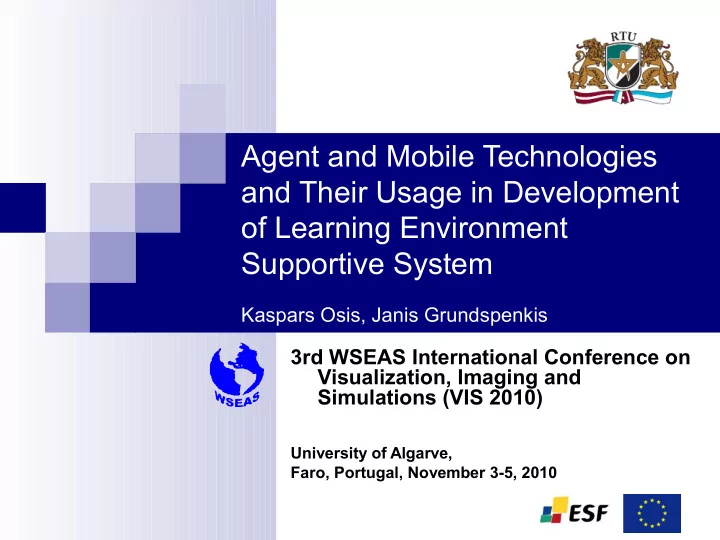

Agent and Mobile Technologies and Their Usage in Development of Learning Environment Supportive System Kaspars Osis, Janis Grundspenkis 3rd WSEAS International Conference on Visualization, Imaging and Simulations (VIS 2010) University of Algarve, Faro, Portugal, November 3-5, 2010
Outline Introduction Aim and perspective of this work Agent technology Mobile technology Agents and mobile devices The case study Conclusions 2
Introduction A shift to the information age; the Internet, … Rapid growth of information amounts Advancement of mobile technologies New mobile devices, forms and ways of communication, wireless services A lack of innovative mobile services The need for new technologies Agent technology in context of mobile devices, ... 3
Aim and perspective of this work A pilot project for acquiring new experience in multi- agent system development on mobile devices A subgoal – to attract more attention to agent and mobile technologies for undergraduate students Perspective - one of several modules of a more complex prototype - a personal knowledge mangement system (PKMS) 4
Agent technology - 1 Human agents vs. Software agents Wooldridge and Jennings “an agent is a computer system situated in some environment, and that is capable of autonomous action in this environment in order to meet its design objectives” Weak notion ( autonomy, social ability, reactivity, pro-activity ) Strong notion ( + mobility, veracity, benevolence, rationality ) 5
Agent technology - 2 Three basic abilities: autonomy, collaboration among themselves, and ability to learn Agent types (by Nwana): collaborative agents, interface agents, mobile agents, information agents, reactive agents, hybrid agents (ACL) Agent communication language ( based on on three Knowledge Sharing Effort (KSE) consortium’s basic approaches: dictionaries, (ontologies) Knowledge Interchange Format (KIF), and Knowledge Query Manipulation Language (KQML) ) 6
Mobile technology - 1 Mobile devices – large diversity (~ 1500) Over 450 different configurations Different screen sizes Different operating systems ( Symbian, Windows Mobile, Linux, Palm, Brew, iPhone, Android, Blackberry ) Several ways of connecting to network ( bluetooth, Wi-Fi, broadband air card, VPN, GSM, 3G, 4G, dial-up, OnStar system, ... ) 7
Mobile technology - 2 Large number of subscribers Weaknesses ( small and different sizes of screens, keyboard, limited memory and execution power, battery, text size and e-mail restrictions, .. ) ESPN example 8
Agents and mobile devices - 1 Mobile devices surpassing previous ones in power and in functionality Right information in the right time Acting on behalf of their owners (i.e. in rapidly changing environment) A lack of innovative mobile services – horizontal growth Agents abilities offer vertical growth solutions ( side effects – enhancements in minimizing a network load, autonomy, ability to adjust to place and to surrounding environment ) 9
Agents and mobile devices - 2 FIPA ( Foundation for Intelligent Physical Agents ) standards – communication, naming, agent life cycle, … Several multi-agent system development environments ( MicroFIPA-OS, CASCOM ) JADE ( Java Agent DEvelopment Framework ) development environment ( simplifies multi-agent system development using FIPA standards, uses FIPA ACL as agent communication language, graphical tools – for example for debugging ) LEAP ( Lightweight Extensive Agent Platform ) project Basic preconditions are there to go forward with an agent-based application development for mobile devices 10
The case study – 1.1 (description) Learning environment supportive system (LESS) Evaluation of grading systems for udergraduate courses in Faculty of Engineering at Vidzeme University of Applied Sciences “Accounting / resource planning systems” course Home works 250 points Research paper presentation 25 points Short quizzes 40 points Active participation in class 75 points Research paper 110 points Final exam 250 points 11
The case study – 1.2 (description) “Active participation in class” - curving approach Point percentage alignment with final mark Percentage Mark Percentage Mark >= 93% (697 p.) = 10 >= 78% (585 p.) = 6 >= 90% (675 p.) = 9 >= 74% (555 p.) = 5 >= 87% (652 p.) = 8 >= 70% (525 p.) = 4 >= 82% (615 p.) = 7 < 70% (525 p.) = 3 Possibility to appeal a mark Processing fee for missed deadline for final mark appeal 12
The case study – 2.1 (architecture) JADE-LEAP as a platform for multi-agent LESS system Partially located on notebook and on three smart phones Wi-Fi connectivity LESS agents' types: instructor agent operator agent student agent audit agent PKMS: time & task agent Standard JADE agents (directory facilitator agent, ...) 13
The case study – 2.2 (architecture) The LESS architecture 14
The case study – 3 (scenarios) The LESS system has four scenarios: (1) setting a mark scenario (2) extending a deadline scenario (3) a mark apealling scenario (4) scheduling an appointment scenario 15
Conclusions The development of LESS prototype has proven the applicability of JADE-LEAP in mobile device and learning environment domain (even though the implementation phase is still in progress) Next steps are to: (*) broaden the usage of JADE-LEAP in PKMS (*) incorporate LESS with personal knowledge management system as a specific learning environment supportive module 16
Thank you! 17
Recommend
More recommend